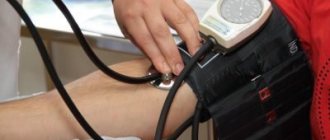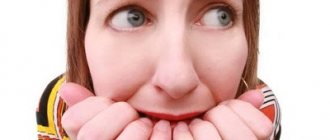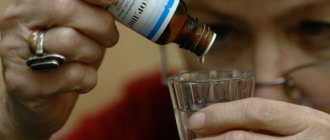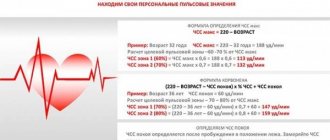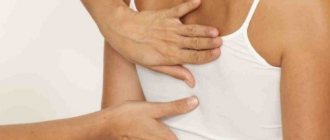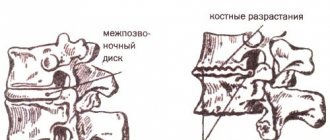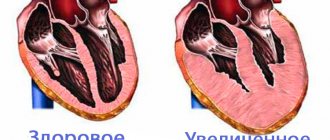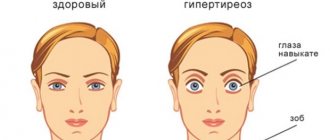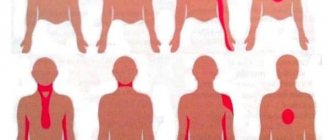Irina Baranova
Cardiologist
Higher education:
Cardiologist
Kuban State Medical University (KubSMU, KubSMA, KubSMI) Level of education - Specialist 1993-1999
Additional education:
“Cardiology”, “Course on magnetic resonance imaging of the cardiovascular system”,
Research Institute of Cardiology named after. A.L. Myasnikova
"Course on functional diagnostics"
NTsSSKh them. A. N. Bakuleva
"Course in Clinical Pharmacology"
Russian Medical Academy of Postgraduate Education
"Emergency Cardiology"
Cantonal Hospital of Geneva, Geneva (Switzerland)
"Therapy course"
Russian State Medical Institute of Roszdrav
Contacts
With vegetative-vascular dystonia, patients often complain of pain in the heart. Dystonia leaves a special imprint on the manifestation of these pains. The symptoms are not fatal, but they significantly exhaust the body, affecting a person’s quality of life. Constant anticipation of a crisis and panic attacks during heart failure are just a few signs of a pathological condition.
Causes of heart pain with VSD
Vegetovascular dystonia develops for a number of reasons:
- exacerbation of chronic diseases;
- hormonal imbalances;
- prolonged stress;
- head injuries.
Typically, pathological processes occur against the background of neuroses and are aggravated by:
- diseases of the respiratory system, gastrointestinal tract, endocrine system;
- weather changes;
- overwork;
- regular use of tobacco and alcoholic beverages.
When experiencing symptoms of dystonia for the first time, patients often experience a panic attack. These sensations seriously traumatize the psyche. Anticipation of the next attack further aggravates the neurosis. A chain of pathological processes provokes heart pain. In addition, risk factors for vegetative-vascular dystonia include:
- excessive physical activity;
- lifting and carrying heavy objects;
- drinking too hot food and drinks;
- premenstrual syndrome in women.
Features of the disease in children
HCV is a borderline state between pathology and health, which is caused by a decrease in the activity of blood vessels and malfunctions of the nervous system in organs. If treatment is not carried out on time, it can cause a disease that is life-threatening.
According to WHO, the most blurred picture of the disease occurs in preschool children:
- this is a period when the function of the vegetative organs is not sufficiently strengthened;
- the child is constantly on the move, his mood often changes, which interferes with the diagnosis;
- Children's pulse is high, so relying on heart rate is not possible.
The main guidelines that are considered when identifying a violation are:
- acquiring skin of a different color;
- the capillary network changes its pattern;
- the functioning of the sebaceous and sweat glands is disrupted, body temperature cannot be regulated;
- the endocrine system fails, itching and swelling appear, puberty in boys slows down, and in girls it accelerates;
- children have apathy, loss of interest in games, constant mood changes, feelings of causeless anxiety and panic;
- shortness of breath appears when taking deep breaths, rapid breathing is replaced by slow breathing, and a strangled cough.
Active life and physical exercise are the best prevention of VSD.
The exact cause of pain in the heart during VSD has not been identified and therefore, if the patient has not established myocardial pathology, he needs, together with the attending physician, to draw up a preventive plan for stopping attacks when it becomes scary and attacks of pain.
You can find out the exact symptoms of dystonia and the causes of heart pain from the video:
You can find out what VSD is fraught with from the video:
Features of pain syndrome in dystonia
Patients describe heart pain during VSD in different ways. They can be piercing, cutting, pressing, raw, aching. Interruptions in cardiac activity, increased heart rate, and a feeling of a foreign body behind the sternum often occur. Pain often radiates to the jaw, neck, left forearm, and shoulder blade area. This condition can pass in a moment, and sometimes lasts for hours. Heart pain with VSD has characteristic features. Pain syndrome:
- appears after any physical activity, but does not appear during the actual activity;
- stops at rest, occurring with any movement (myositis, intercostal neuralgia);
- accompanied by a feeling of anxiety, panic attack;
- not controlled by “cardiac” drugs (Validol, Nitroglycerin);
- becomes less intense after taking sedatives (Corvalol, Phenazepam);
- combined with the fear of death, which grows with the next crisis.
Examinations do not reveal any serious heart pathologies. An ECG may detect incomplete blockade of one of the branches of the Hiss bundle, but this does not affect the state of health. In cardiology, such a deviation is considered as a variant of the physiological norm.
Extrasystole in dystonia is of a neurogenic nature. Usually healthy people with extraordinary heart contractions do not notice this, but with VSD they are noticeable. The patient feels that his heart cannot cope with such arrhythmias. They provoke numbness and panic. But doctors say: interruptions in the work of the heart and its “fading” with vegetative-vascular dystonia only seem to patients.
Why does the heart hurt with VSD?
Often, VSD is not taken seriously by a person and is attributed to fatigue. Meanwhile, the disease progresses, causes more unpleasant symptoms, and leads to complications in the form of hypertension and other vascular diseases. Heart pain is the most frightening symptom, pushing for decisive action, and the person is sent for a consultation with a therapist. But after conducting an examination, it turns out that the organs and systems of the SS are in order.
Enter your pressure
Move the sliders
120
on
80
The fact is that the name “vegetative-vascular”, although it hints at a problem with blood vessels, has nothing to do with them. This is a disease of the autonomic nervous system.
Heart pain is an unpleasant symptom, since it can intensify the patient’s already anxious state, provoking a panic attack, causing fear and fear for life. Scientists are still arguing about the causes of unpleasant sensations in the heart during VSD, and have settled on the following points:
- Physical exercise. This includes lifting heavy objects, playing competitive sports, and even going for long walks.
- Psychological stress. The disease is psychosomatic, so during stressful situations the risk of a panic attack increases, and with it dizziness and cardiac pain.
- Lack of sleep and lack of air. For normal functioning of organs, healthy sleep and rest are required. It is better to ventilate the room before going to bed.
- Female body. According to statistics, women are more susceptible to the disease than men. This is due to the characteristics of the female body, namely hormonal changes during menstruation.
Pathological pain
Sometimes heart pain with VSD occurs not only due to disorders inherent in the condition, but also due to serious organic disorders. With heart failure, blood circulation in the coronary arteries partially or completely stops. In combination with coronary artery disease, this condition can provoke the development of a heart attack or sudden cardiac arrest.
During a heart attack, the nature of the pain is very pronounced, it spreads to the peritoneum, scapula, neck, and left arm. Shortness of breath develops and a dry cough appears. The duration of such an attack is over 15 minutes. With atypical development of a heart attack, there is no pain syndrome.
Angina pectoris is characterized by a cutting or dull pain behind the sternum, radiating under the left shoulder blade. Shortness of breath and air deficiency occur. Sometimes there is no specific localization of pain. The attack lasts from a few moments to 20 minutes and is easily relieved with Nitroglycerin. In both cases, accurate diagnosis and subsequent therapy are necessary.
Feeling pain in the heart area as a symptom of VSD
The main problem that patients face is constant aching sensations in the heart and sternum. The patient may experience an acute feeling of fear of death, which increases the duration of the attack and worsens general well-being.
Gradually, additional symptoms and signs appear, making diagnosis difficult. Unpleasant sensations in the heart area spread to neighboring organs, often localized in the chest, left arm and lower part of the face. Patients complain of discomfort in the intestines, lungs and decreased performance. Each time an attack of pain in the heart during VSD becomes longer and more severe.
Pain in the vegetative-vascular system with dystonia manifests itself in different ways. Problems of heart pain bother patients after nervous shocks, with regular disruption of sleep and rest patterns, and under other circumstances. With autonomic dysfunctions in VSD, the symptoms are as follows:
- insomnia and shallow sleep;
- dizziness;
- chills or feeling hot;
- weakness and increased fatigue;
- pressure fluctuations (decrease or increase);
- numbness of limbs, convulsions.
Symptoms depend on the general health of the person, age and the presence of concomitant pathologies. The main symptom for all patients with dystonia is pain, which interferes with normal life and work. The person becomes irritable and tense, as he is constantly waiting for the next attack. The pain can be so severe that it becomes difficult to breathe. The condition is often accompanied by panic attacks.
Is VSD syndrome dangerous?
Doctors do not agree on the danger of VSD. Some experts believe that all symptoms can be easily eliminated by lifestyle changes. Other doctors offer treatments aimed at relieving the condition. The truth lies somewhere between these two points of view.
To avoid complications, dystonia must be treated. To do this, determine the exact set of symptoms accompanying the pathology. A consultation with a psychotherapist is also required, since heart pain is often combined with depression, neuroses or other diseases. Only through the joint efforts of specialists from different fields can it be possible to select effective treatment.
Additional symptoms of VSD
A feature of vegetative-vascular dystonia is the ability to masquerade as other diseases. This increases the risk of reacting incorrectly to the situation. Heart attacks, angina pectoris, and other dangerous heart pathologies have similar symptoms. They require urgent assistance, as there is a high probability of death. To avoid this, you need to know how the heart hurts during VSD.
How to distinguish heart pain from VSD:
- Occurs regardless of physical activity.
- Often appears after stress or severe emotional shock.
- Accompanied by fear of death and anxiety.
- Does not decrease when exposed to vasodilator drugs.
The appearance of heart pain during VSD is facilitated by lack of sleep, alcohol consumption and neglect of physical activity. People prone to a sedentary lifestyle are faced with cervical osteochondrosis. For this reason, patients are sure that they are worried about pain in the heart, and problems have arisen in the spine. If a person suffers from chest pain, the presence of other diseases should be excluded. Against the background of constant violations of the daily routine and self-medication, arrhythmias occur, and in severe cases, the likelihood of a heart attack increases.
The nature of pain in the heart during VSD may change, but traditionally patients complain of a feeling of compression in the sternum. At the same time, no changes in the heart are observed on ultrasound, and mild arrhythmia is sometimes visible on ECG. After an additional examination, treatment for VSD is selected, which depends on the symptoms, age of the patient and other factors.
First aid
When experiencing heart pain, it is necessary to minimize the likelihood of developing a heart attack and cardiac arrest:
- call emergency help;
- sit down or lie down;
- release the chest;
- provide a flow of fresh air;
- take a tablet of Nitroglycerin (if the pain continues after 3-5 minutes, take another one) and Aspirin.
If emergency assistance is not provided within half an hour from the onset of the attack, in the presence of cardiac pathologies, it will be difficult to avoid the development of negative consequences. In any case, after pain relief, you should visit a cardiologist.
Causes of the syndrome
Patients who have had to deal with signs of vegetative dystonia often experience fear if they do not know about the relative safety of this pathological condition. Pain in the heart can traumatize the psyche, as a person is afraid of the onset of a new pain attack.
One of the causes of pain in the chest is neurogenic cardialgia. It is characterized by a wave-like manifestation with a duration of 3–5 minutes. Unpleasant sensations may last for a couple of hours or may persist for several days.
Along with pain, the patient has:
- anxiety;
- feeling of fear;
- increased heart rate;
- profuse sweating;
- dyspnea.
With cardialgia, patients describe their complaints quite vividly and accurately.
Another factor that can lead to pain in the heart during VSD is cardioneurosis. In this condition, the patient experiences the following symptoms:
- rapid heartbeat, feeling that the heart is jumping out;
- lack of air;
- sleep disorder;
- cephalgia;
- mood swings.
Pain in the heart during cardioneurosis usually occurs due to emotional stress, hormonal changes in the body, the development of somatic diseases, infectious pathologies, and skull injuries.
Doctors also attribute a malfunction in the functioning of endocrine organs to the causes of pain in the heart during VSD. This could be hypothyroidism or diabetes. Pain in the chest appears due to the body's reaction to these pathologies. Along with it, symptoms such as asthenia, interruptions in heart rhythm, tachycardia, and surges in blood pressure appear.
Problems with the functioning of the heart itself should not be excluded from the list of causes of heart pain. It is not always possible to connect the presence of VSD and pain, since against the background of autonomic dysfunction, the patient could develop some kind of cardiovascular disease, for example, heart failure.
ATTENTION!!!
If heart pain occurs during VSD, it is necessary to undergo an urgent examination. Only diagnostics will show what this manifestation is associated with - autonomic dysfunction or heart disease.
Therapy of heart pain in VSD
Signs of heart pain in vegetative-vascular dystonia are similar to manifestations of other pathologies. A comprehensive examination will help to accurately determine the cause of their occurrence, in particular:
- blood analysis;
- Ultrasound;
- ECG;
- MRI.
To relieve anxiety and anxiety during VSD, sedatives (Corvalol, Valocordin) are prescribed - according to an individual regimen until the symptoms are eliminated. For prolonged panic attacks, severe anxiety, irritability, and insomnia, it is recommended to take Phenazepam (exclusively as prescribed by a doctor and under his supervision).
Working patients leading an active life are prescribed “daytime tranquilizers” - Mebicar, Phenibut, Gidazepam. The vegetative corrector salbutiamine in Enerion has a good anti-asthenic effect. Additionally, psychotherapy and massage are used. It is recommended to make adjustments to your lifestyle and usual diet.
Diagnosis of VSD
When a person comes to the clinic, an examination of the organs in which pain is bothersome is prescribed:
- clinical examination of urine and blood;
- biomaterial samples to identify malfunctions of the autonomic nervous system;
- to identify damage to the heart muscle, if there is severe pain in the heart at the time of exacerbation during VSD, ECHO and electrocardiography are performed;
- The functionality of the central nervous system is assessed using electro- and echoencephalography.
To identify why the heart hurts, in case of VSD, examinations are carried out by a neurologist, ophthalmologist, cardiologist, ENT specialist and psychiatrist. Heredity is of great importance. When compiling an anamnesis, the presence of VSD in close relatives is established.
Prevention of pathological condition
Many experts consider vegetative-vascular dystonia to be a hereditary disease. However, there are certain measures to prevent dystonia and, accordingly, the accompanying heart pain. To do this you need:
- provide adequate nutrition;
- give up smoking and alcohol;
- observe the rest and work regime;
- do physical education;
- Visit your therapist and cardiologist regularly.
If possible, it is necessary to avoid stressful situations, psycho-emotional and physical overload. If problems arise, you should not hesitate to consult a psychotherapist.
The exact causes of heart pain in vegetative-vascular dystonia have not yet been studied. If no cardiac abnormalities are detected during the examination, the risk of serious complications is low. It is only necessary, together with your doctor, to select the optimal regimen for stopping attacks and remember about preventive measures.
General characteristics of pain
Pain in the heart region with vegetative-vascular dystonia is diagnosed in most cases. This symptom does not mean that a person has serious heart disease, but may indicate some abnormalities in its functioning.
Pain can have a different character, intensity, and manifest itself both during physical activity and at rest. The characteristics of the pain syndrome may depend on the degree to which VSD occurs. Usually the symptom torments the patient during an exacerbation of the disease.
Soreness does not appear in the heart itself, but in areas near it and can radiate to other parts of the body. Patients note that there is a tingling, pressing, burning sensation in the area of the heart.
First aid for VSD and heart pain
If a person feels irregular heartbeat, cannot perform his usual work, feels panic and weakness, he needs help. Below are the basic principles of first aid that everyone should know:
- stop physical activity, lie down or sit down. Tight clothes need to be loosened, buttons at the throat should be undone;
- if a person becomes ill indoors, it is necessary to provide access to air;
- Nitroglycerin is given under the tongue - 1 tablet three times every 5 minutes, you can take Aspirin;
- measure your pulse. If the readings are more than 110 per minute, you can take Anaprilin.
First aid is provided within the first half hour after the attack, in this case there is a possibility that the development of the pathology will stop and the person will be fine by the time the doctors arrive. Even in the presence of VSD, the development of vascular pathologies cannot be excluded, therefore, after stabilization of the condition, you need to undergo examination by a cardiologist.
Symptoms of pathology and features of the course
Having consulted a doctor, patients suffering from VSD present a large number of complaints, which are not confirmed during a comprehensive examination and study of organs. The cause of the sensations that arise is a violation of the autonomic nervous system.
There are certain symptoms that appear during the disease:
- insomnia, sleep disturbance,
- malaise, lethargy, fatigue,
- temperature rise to 37-37.5 °C,
- dizziness, headaches, loss of consciousness,
- sudden changes in excessive sweating and chills,
- heart pain, pressure drop, panic disorders.
The age of patients ranges from childhood to retirement. The disease is especially pronounced in adolescents and women during menopause.
The course of the disease is mostly hidden with short-term or long-term attacks that appear:
- with increased psycho-emotional stress,
- with mental or physical stress,
- at the time of infectious diseases.
The aching pain in the heart does not completely go away during the treatment of VSD, since it is completely impossible to get rid of the disease. Therefore, after clarifying the diagnosis, medications are prescribed to help relieve symptoms. The period of remission can range from several days to several years, depending on the environment.
It is impossible to diagnose the disease on your own, since pain in the VSD heart area manifests itself differently in everyone. Patients complain that they have a stabbing sensation in their chest, but the pain can be aching or pressing. Often during attacks there is a sensation in the area of the heart of a foreign object, constraining and interfering with movement, giving an uncomfortable burning sensation.
With VSD, the localization of pain is observed not only in the chest, it covers the territory of the shoulder blades, the cutting nature of the pain occurs below the collarbone, and there is a frequent transition to the neck, jaw and teeth, and left arm. Painful sensations may:
- gradually intensify and subside,
- be of a paroxysmal nature,
- last from a couple of seconds to several hours.
Pain in the heart may appear after a heavy meal, which is typical only with VSD.
Preventive actions
Heart pain is an unpleasant symptom that often takes a person by surprise and causes fear. Therefore, you should carefully monitor your health, preventing the development of vegetative-vascular dystonia. To do this, it is enough to follow the basic principles of a healthy lifestyle.
These include the following:
- balanced diet;
- rejection of bad habits;
- correct daily routine;
- playing sports;
- avoidance of stress and anxiety;
- annual examination by a cardiologist.
Heart pain with VSD should be a serious reason to see a doctor. After all, it is not always autonomic dysfunction that causes pain. Dystonia may be hiding serious heart damage that requires immediate treatment.
Vegetative-vascular dystonia is one of the most common diseases, which, however, is not mentioned in the International Classification of Diseases. Some doctors even refuse to recognize such a disease, citing the fact that its symptoms are not capable of harming human health. However, heart pain during VSD can significantly reduce the patient’s quality of life, so this disease should not be neglected.
Preventive measures
In modern medicine, VSD is considered to be a hereditary pathology. However, there are several recommendations regarding its prevention:
- balanced diet with minimization of fatty and fried foods, which negatively affect the condition of blood vessels;
- regular physical activity;
- compliance with rest, work and nutrition regimes;
- eliminating bad habits such as smoking and alcohol;
- avoiding stress, physical and emotional overload, as well as depression.
Vegetative-vascular dystonia is not considered a dangerous disease in modern medicine. Some doctors do not take the disease seriously at all, attributing its manifestations to stress and the body’s reaction to an incorrect lifestyle.
However, the disease is widespread and can significantly impair the patient's quality of life when severe heart pain occurs with VSD. Therefore, when the symptoms described above appear, the patient should seek professional help, which will allow him to return to normal work ability and reduce the unpleasant manifestations of the syndrome.
